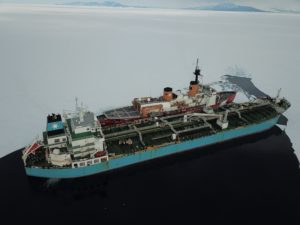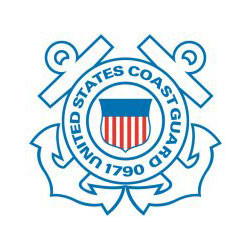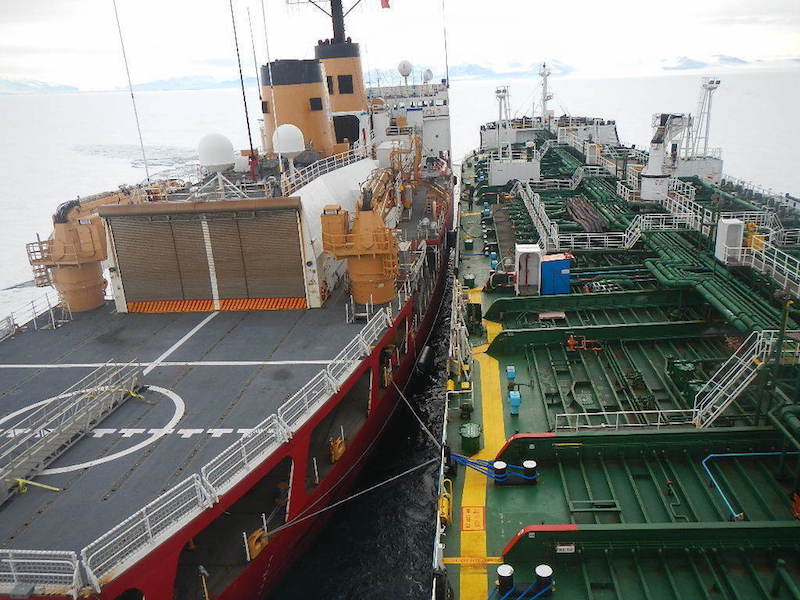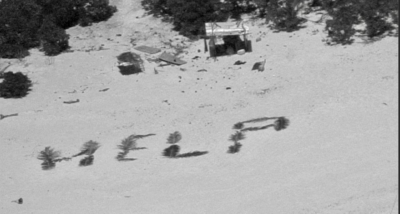The 159 crewmembers onboard the Coast Guard cutter Polar Star (WAGB 10) departed McMurdo Station Wednesday after escorting three refuel and resupply vessels and assisting with a five-day inspection of foreign research stations, installations and equipment in Antarctica.
The departure marks the Polar Star’s 23rd journey to Antarctica in support of Operation Deep Freeze, an annual joint military service mission to resupply the United States Antarctic stations, in support of the National Science Foundation, the lead agency for the United States Antarctic Program.

The Coast Guard cutter Polar Star is moored Feb. 5, 2020, next to the Maersk Peary in McMurdo, Antarctica. The crew of the 44-year-old icebreaker created a channel in the ice near McMurdo Station as a part of Operation Deep Freeze. Coast Guard photograph by Senior Chief Petty Officer NyxoLyno Cangemi
The Seattle-based 399-foot, 13,000-ton Polar Star created a 23-mile channel through the ice to McMurdo Sound, which enabled the offload of over 19.5 million lbs. of dry cargo and 7.6 million gals. of fuel from three logistics vessels. Together these three ships delivered enough fuel and critical supplies to sustain NSF operations throughout the year until Polar Star returns in 2021.
The Polar Star also supported a team of U.S. government officials from the U.S. Department of State, National Science Foundation, National Oceanic and Atmospheric Administration and U.S. Coast Guard who conducted a five-day inspection of foreign research stations, installations, and equipment in Antarctica.
The U.S. continues to promote Antarctica’s status as a continent reserved for peace and science in accordance with the provisions of the Antarctic Treaty of 1959. The inspection serves to verify compliance with the Antarctic Treaty and its Environmental Protocol, including provisions prohibiting military measures and mining, as well as provisions promoting safe station operation and sound environmental practices.
The team inspected three stations: Mario Zucchelli (Italy), Jang Bogo (South Korea), and Inexpressible Island (China). This was the 15th inspection of foreign research stations by the U.S. in Antarctica, and the first since 2012.

Military Sealift Command chartered ship MT Maersk Peary conducts an at-sea fuel transfer with the United States Coast Guard icebreaker Polar Star. The Peary offloaded nearly eight million gallons of diesel and jet fuel. USCG photo by Sarah Burford
Inspections emphasize that all of Antarctica is accessible to interested countries despite territorial claims and reinforce the importance of compliance with the Antarctic Treaty’s arms control provisions. The U.S. will present its report on the inspection at the next Antarctic Treaty Consultative Meeting in Helsinki, Finland, in May 2020.
“I am immensely proud of all the hard work and dedication the men and women of the Polar Star demonstrate each and every day,” said Greg Stanclik, commanding officer of the Polar Star.
“Maintaining and operating a 44-year-old ship in the harshest of environments takes months of planning and preparation, long workdays and missed holidays, birthdays and anniversaries with loved ones. The Polar Star crew truly embodies the ethos of the Antarctic explorers who came before us — courage, sacrifice and devotion.”
Commissioned in 1976, the Polar Star is the United States’ only operational heavy icebreaker, capable of breaking ice up to 21 feet thick. Reserved for Operation Deep Freeze each year, the ship spends the winter breaking ice near Antarctica, and when the mission is complete, returns to dry dock in order to conduct critical maintenance and repairs in preparation for the next Operation Deep Freeze mission.
If a catastrophic event, such as getting stuck in the ice, were to happen to the Coast Guard cutter Healy (WAGB 20) in the Arctic or to the Polar Star near Antarctica, the Coast Guard is left without a self-rescue capability.
By contrast, Russia currently operates more than 50 icebreakers – several of which are nuclear powered.
The Coast Guard has been the sole provider of the nation’s polar icebreaking capability since 1965, and is seeking to increase its icebreaking fleet with six new polar security cutters to ensure continued national presence and access to the Polar Regions.
In April, the Coast Guard awarded VT Halter Marine Inc., Pascagoula, Miss., a contract for the design and construction of the Coast Guard’s lead polar security cutter, which will also be homeported in Seattle. The contract also includes options for the construction of two additional PSCs.
"Replacing the Coast Guard's icebreaker fleet is paramount," said Vice Adm. Linda Fagan, commander of the Coast Guard's Pacific Area. "Our ability to clear a channel and allow for the resupply of the United States' Antarctic stations is essential for continued national presence and influence on the continent."





